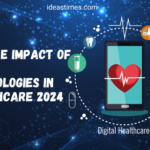In 2024, the healthcare industry is experiencing rapid advancements driven by emerging information technology (IT) trends. These innovations are reshaping how medical care is delivered, managed, and experienced. Understanding these healthcare IT trends can help patients, healthcare providers, and industry professionals navigate the evolving landscape. Here’s a look at the top healthcare IT trends that are transforming patient care this year.
- Telemedicine Expansion
Telemedicine has been a cornerstone of healthcare IT for years, but its growth in 2024 is particularly noteworthy. With advancements in video conferencing technology and telehealth platforms, patients can now receive high-quality care from the comfort of their homes. This trend not only enhances accessibility for individuals in remote or underserved areas but also reduces wait times and the strain on healthcare facilities. Features like real-time consultations, remote monitoring, and integrated electronic health records (EHRs) are making telemedicine more efficient and effective, aligning with broader healthcare IT trends.
- Artificial Intelligence (AI) Integration
Artificial Intelligence (AI) is making significant strides in the healthcare sector. AI algorithms are being used to analyze complex medical data, such as imaging and lab results, with incredible precision. For example, AI-powered tools can detect early signs of diseases like cancer and cardiovascular conditions by recognizing patterns that may elude human practitioners. AI is also playing a crucial role in personalized medicine by predicting patient responses to various treatments, thereby optimizing therapeutic approaches and improving outcomes. This reflects the growing influence of healthcare IT trends in driving innovation.
- Wearable Health Technology
Wearable health technology continues to evolve, offering more sophisticated features to monitor and manage health. In 2024, we see an increase in the use of smartwatches, fitness trackers, and other wearable devices that provide real-time health data. These devices can track vital signs, sleep patterns, and physical activity, and even alert users to potential health issues. The integration of wearables with healthcare IT systems allows for seamless data sharing with healthcare providers, facilitating proactive management of chronic conditions and overall health improvement.
- Blockchain for Health Data Security
As concerns about data privacy and security grow, blockchain technology is emerging as a powerful solution for safeguarding health information. Blockchain creates a decentralized and immutable ledger of patient records, ensuring that sensitive data is protected from unauthorized access and tampering. This technology enhances data integrity, enables secure data sharing among authorized parties, and empowers patients with greater control over their health information. By leveraging blockchain, healthcare organizations can address security challenges and build trust with patients, a key aspect of modern healthcare IT trends.
- Personalized Medicine Advances
Personalized medicine is becoming increasingly prevalent, thanks to advancements in genomics and biotechnology. This trend involves tailoring medical treatments to the individual characteristics of each patient, based on their genetic makeup and other personal factors. In 2024, personalized medicine is leveraging healthcare IT trends to analyze large datasets and develop customized treatment plans. This approach not only improves the effectiveness of treatments but also reduces the risk of adverse reactions, leading to better patient outcomes and enhanced quality of care.
- Robotic Surgery and Automation
Robotic surgery and automation are transforming surgical procedures by offering enhanced precision and control. Modern robotic systems equipped with advanced sensors and high-definition cameras allow surgeons to perform complex operations with greater accuracy and minimal invasiveness. In 2024, robotic surgery is becoming more accessible and widely adopted, leading to shorter recovery times, reduced surgical risks, and improved patient outcomes. Automation in other areas of healthcare, such as administrative tasks and patient management, is also streamlining processes and increasing efficiency.
The Impact of Healthcare IT Trends
The integration of these healthcare IT trends is significantly impacting the healthcare industry. Telemedicine and wearable health technology are improving accessibility and patient engagement, while AI and blockchain are enhancing diagnostic accuracy and data security. Personalized medicine and robotic surgery are advancing treatment options and surgical precision, respectively.
These innovations are not only addressing current challenges but also paving the way for a more efficient and patient-centered healthcare system. As technology continues to advance, staying informed about these trends will help patients and healthcare providers make informed decisions and leverage the benefits of modern healthcare IT solutions.
Conclusion
The healthcare IT trends of 2024 are setting new standards for patient care and medical practice. From the expansion of telemedicine to the integration of AI and blockchain, these advancements are reshaping the industry and offering new possibilities for improving health outcomes. By understanding and embracing these trends, stakeholders can navigate the evolving landscape of healthcare and harness the power of technology to enhance the quality and efficiency of care.


